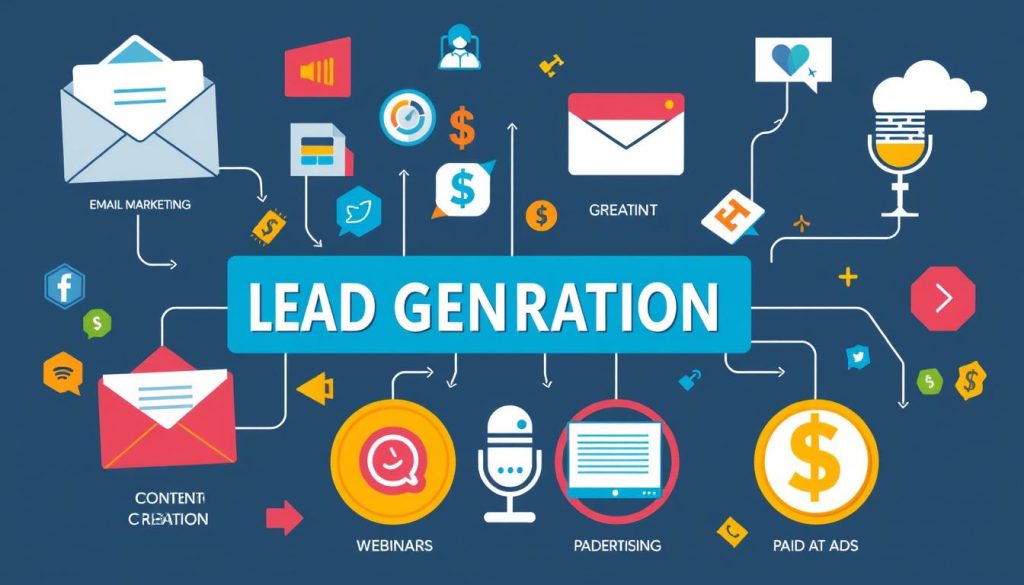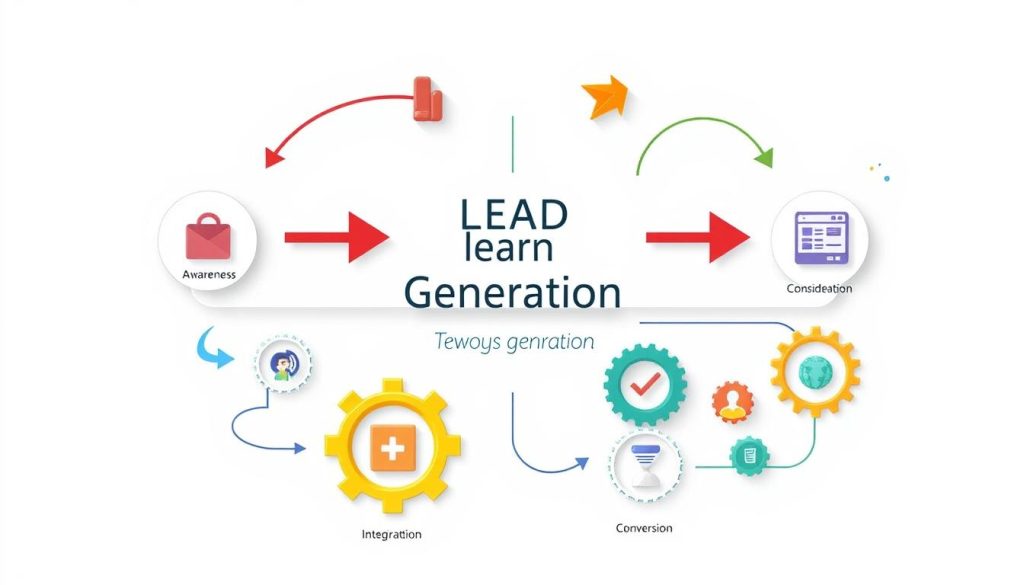Lead generation is vital for business sales. A lead is someone who might become a customer. Different industries use various strategies, but the goal is the same. This blog explores lead generation workflows and strategies to boost your results.
We’ll uncover ways to get more potential customers for your products or services. You’ll learn how to manage the process from start to finish.
Key Takeaways
- Understand the importance of lead generation in driving business growth.
- Explore different types of lead generation methods to find the right fit for your business.
- Learn how to effectively manage the lead generation process, from acquisition to conversion.
- Discover tools and techniques to streamline data collection and lead nurturing.
- Optimize your lead generation process for maximum conversions and revenue growth.
Movix.ai can boost your traffic through Reddit. It finds the perfect conversations to mention your product. The AI also drafts suggested replies for you.
Understanding Lead Generation
Lead generation is the process of finding potential customers for your business. It aims to get contact info from people interested in your products or services. This sets the stage for future engagement and sales.
The goal is to convert these leads into paying customers. This process is crucial for business growth and success.
What is Lead Generation?
Lead generation creates consumer interest in your offerings. It uses various marketing techniques like content creation and social media outreach. These methods aim to get potential customers’ contact details.
This allows your sales team to nurture leads. They can then guide them towards making a purchase decision.
The Importance of Lead Generation
Effective lead generation is vital for all businesses. It directly impacts your organization’s growth and success. A steady stream of qualified leads can increase website traffic.
It also builds a strong sales pipeline. Without a good strategy, businesses struggle to find their target audience. This makes it hard to drive revenue and achieve growth.
A lead is a potential customer interested in your products. Lead generation is the process of finding and attracting these leads. Understanding this difference helps businesses develop effective nurturing strategies.
“Successful lead generation is the lifeblood of any business. It’s the catalyst that turns prospects into customers and drives sustainable growth.” – Jane Doe, Marketing Strategist
Different Types of Lead Generation Methods
High-quality leads are essential for business success. Various effective methods exist to generate leads. Content marketing, social media marketing, and search engine optimization are popular strategies.
Pay-per-click (PPC) advertising targets potential customers precisely. It drives immediate traffic to your website. Email marketing nurtures leads through personalized communication.
Referral programs and webinars and events can generate leads effectively. They use word-of-mouth and provide valuable content. Partnerships and affiliates open new channels for lead generation.
Try different lead generation methods. Track your results and optimize your approach. This ensures maximum effectiveness.

“The key to successful lead generation is to find the right mix of strategies that resonate with your target audience and align with your business goals.”
The Transition of Leads through the Buying Journey
Getting a new lead is just the start of selling. A strong sales funnel is key to turning prospects into customers. The six stages of the lead funnel are vital for success.
Understanding these stages helps improve the path to purchase. By focusing on each step, you can boost your sales efforts.
The Six Stages of the Lead Funnel
- Prospect Stage: People first learn about your product or service. They might find you through ads, friends, or their own search.
- Lead Stage: Prospects become leads when they show interest. This could be by signing up for emails or downloading content.
- Marketing Qualified Lead (MQL) Stage: Leads are scored based on their engagement. Those ready for sales are called marketing qualified leads.
- Sales Qualified Lead (SQL) Stage: The sales team reviews MQLs. They decide which ones are ready for a sales pitch.
- Opportunity Stage: The sales team talks with the lead. They spot a chance for a sale.
- Customer Stage: The lead becomes a paying customer. This marks the end of the lead funnel.
Improving each stage of the lead funnel is crucial. It helps make your lead generation and sales more effective.
The Importance of a Lead Generation and Processing Mechanism
Lead generation fuels successful businesses in digital marketing. But generating leads is just the start. A robust lead processing system maximizes their value.
Effective lead management ensures proper nurturing and qualification. Timing is crucial when approaching leads. A well-structured workflow guides leads through the buying process.
Lead qualification identifies promising opportunities. It helps optimize sales and marketing resources. This process focuses efforts on leads most likely to convert.
| Lead Generation and Processing Mechanism | Benefits |
|---|---|
| Structured lead management workflow | Ensures leads are nurtured and qualified effectively |
| Efficient lead qualification process | Helps prioritize the most promising leads |
| Integrated lead nurturing strategies | Keeps leads engaged and moving through the sales funnel |
A comprehensive lead generation and processing mechanism unlocks growth potential. It maximizes lead value and drives sustainable business success.

The Lead Generation Process Flow
Effective lead generation is vital for businesses to attract potential customers. It involves several key steps from initial contact to successful sale. This approach helps convert prospects into customers.
Lead Acquisition
The first step is acquiring leads through various marketing tactics. These include PPC advertising, SEO, and content marketing. Businesses can collect personal information by driving prospects to landing pages.
This data helps start the nurturing process. It’s crucial for building relationships with potential customers.
Lead Nurturing
After acquiring leads, businesses focus on nurturing them. This involves educating prospects and answering their questions. It also guides them closer to making a purchase decision.
Tactics like email marketing and personalized content help build trust. Targeted social media campaigns can also foster strong relationships with leads.
Marketing Lead Qualification
As leads progress, it’s important to qualify them. This ensures they’re genuinely interested and ready to engage. Marketing lead qualification identifies the most promising prospects.
This process allows sales teams to focus on qualified leads. It increases the chances of converting leads into customers.
Understanding this process helps businesses streamline their efforts. It improves lead acquisition, nurturing, and qualification. Ultimately, it drives more successful sales outcomes.
Sales Transfer
The sales transfer is a crucial step after marketing qualifies a lead. It’s when the lead moves to the sales team. This handoff helps sales focus on prospects more likely to convert.
Sales transfer involves smoothly passing leads from marketing to sales. Tools like Salespanel can help qualify leads based on set criteria. Then, the best leads are sent to sales reps.
Marketing teams use lead scoring to assess prospect quality. Qualified leads are then given to sales with key information. This helps with follow-up and conversion.
Sales and marketing work together for a smooth handoff. They share feedback and improve the process for better results. This teamwork is vital for effective sales transfer.
- Lead Qualification: Marketing teams use lead scoring and other techniques to assess the quality and sales-readiness of each prospect.
- Lead Transfer: Qualified leads are then passed on to the sales team, along with relevant information to facilitate efficient follow-up and conversion.
- Collaboration: Sales and marketing work together to ensure a smooth handoff, sharing feedback and optimizing the process for better results.
Good sales transfer is key to successful lead generation. It aligns marketing and sales efforts. This helps businesses get more from their lead generation work and grow steadily.
“The sales transfer stage is the bridge between marketing’s efforts and the sales team’s success. It’s where the magic happens.”

lead generation process flow
The lead generation process flow is vital for successful marketing strategies. It outlines steps to attract, nurture, and convert potential customers. By optimizing this flow, businesses can boost their lead generation efforts.
The lead generation process flow has four key stages:
- Lead Acquisition: Attracting potential customers through various marketing channels, such as search engine optimization, social media, content marketing, and paid advertising.
- Lead Nurturing: Engaging with leads, building trust, and providing valuable information to guide them through the buying journey.
- Lead Qualification: Identifying the most promising leads and determining their level of sales-readiness.
- Sales Transfer: Handing off qualified leads to the sales team for further engagement and conversion.
Optimizing each stage ensures a steady pipeline of high-quality leads. This approach can boost a company’s growth and profitability.
A holistic strategy for lead generation can transform a business. It creates opportunities for success and increased conversions.
“The key to successful lead generation is to create a seamless, data-driven process that guides prospects from initial engagement to final conversion.”
Lead Qualification
Lead qualification is crucial in lead generation. It helps sales teams identify promising prospects. This assessment lets businesses prioritize outreach to leads most ready to convert.
Teams analyze factors like interest, budget, and decision-making authority. This helps them focus on leads with the highest conversion potential.
Leveraging Tools for Lead Qualification
Businesses use specialized tools to enhance lead qualification efforts. Lead scoring and lead qualification tools automate much of the process. These platforms analyze data points to score leads.
Sales teams can quickly spot warm prospects with these tools. This allows for better resource allocation and efficiency.
Salespanel offers comprehensive lead qualification features. It integrates with CRM and marketing automation systems. The tool analyzes behavioral and demographic data to assess lead fit.
Sales pros can engage promising leads more effectively. They can also nurture leads needing more time to decide.
“Effective lead qualification is the cornerstone of any successful sales strategy. By leveraging the right tools, businesses can ensure they’re focused on the prospects most likely to convert, ultimately driving greater efficiency and profitability.”
| Feature | Benefit |
|---|---|
| Automated Lead Scoring | Prioritize high-potential leads based on customizable criteria |
| Behavioral Tracking | Monitor lead activities and engagement to uncover buying signals |
| CRM Integration | Seamlessly incorporate lead data into existing sales workflows |
| Customizable Qualification Criteria | Tailor the qualification process to the unique needs of your business |
Lead qualification tools streamline sales pipelines. They help businesses focus on promising prospects. This leads to higher conversion rates and revenue growth.
Data Collection
Collecting valuable data is vital for lead generation. Businesses use online forms, surveys, social media, and digital ads to gather customer information. However, managing this process can be time-consuming and error-prone.
Tools like SaveMyLeads simplify data collection. It streamlines the process and ensures smooth information transfer from various sources into your CRM system.
Streamlining Data Collection with SaveMyLeads
SaveMyLeads is a powerful data collection tool. It automates information transfer from multiple sources, including:
- Online forms and surveys
- Social media interactions
- Digital advertising campaigns
SaveMyLeads integrates seamlessly with your CRM system. It centralizes all lead data collection, making it easily accessible. This eliminates manual data entry and reduces errors.
SaveMyLeads offers advanced analytics and reporting features. These tools provide deeper insights into your lead generation efforts. You can make informed decisions to improve your overall strategy.
“SaveMyLeads has been a game-changer for our lead generation process. It has significantly reduced the time and effort required to collect and manage data, enabling us to focus on nurturing and converting our leads more effectively.”
– John Doe, Marketing Manager at ABC Corporation
Lead Nurturing Strategies
Lead nurturing develops relationships with potential customers. It guides them through the sales funnel. By providing valuable content, businesses can build trust and keep prospects engaged.
Segmenting leads is an effective lead nurturing strategy. It allows businesses to tailor content to specific needs. This increases the chances of conversion.
Developing targeted content addresses audience pain points. This could include blog posts, webinars, or email campaigns. Lead engagement nurtures relationships and maintains interest.
Automated tools like SaveMyLeads enhance the lead nurturing process. They streamline data collection and communication. These tools track engagement and optimize lead management strategies.

Effective lead nurturing strategies build stronger relationships with prospects. They increase conversion chances. This ultimately drives more revenue for businesses.
Conversion Optimization
Conversion turns potential leads into customers. It involves personalized communication, valuable content, and persuasive calls-to-action. SaveMyLeads can boost this process and improve results.
Integrating SaveMyLeads for Conversion Tracking
SaveMyLeads can revolutionize your lead conversion efforts. This tool tracks marketing campaign performance and lead behavior. It helps make data-driven decisions to improve conversion rate optimization strategies.
SaveMyLeads offers several benefits. It automates lead nurturing and follow-up tasks. The tool provides insights into lead preferences and behavior.
You can measure marketing impact and optimize strategies with SaveMyLeads. It streamlines operations and enhances lead conversion optimization efforts. Ultimately, it drives more successful conversions.
- Automate lead nurturing and follow-up tasks, ensuring timely and personalized communication with your leads.
- Gain valuable insights into lead preferences, interests, and behavior, allowing you to tailor your lead conversion optimization tactics.
- Measure the impact of your marketing efforts and make informed decisions to optimize your lead generation and conversion strategies.
“Integrating SaveMyLeads into our lead generation process has been a game-changer. The insights and automation capabilities have helped us optimize our conversion strategies and drive tangible results.”
– John Doe, Marketing Manager at ABC Company
Conclusion
An effective lead generation process is crucial for business growth. Understanding the stages from lead acquisition to conversion optimization helps streamline efforts. This approach improves chances of attracting and converting potential customers.
Tools like SaveMyLeads can boost lead generation efficiency. They ensure no potential lead is missed. The sales team can focus on the most qualified prospects.
Integrating lead generation process, strategy, and best practices creates a robust system. This approach drives growth and success. It’s scalable for future needs.
Effective lead generation requires a comprehensive strategy. It should consider the entire customer journey. Mastering this art positions businesses for long-term success. It also secures a competitive edge in their markets.
FAQ
What is Lead Generation?
Why is Lead Generation Important?
What are the Different Types of Lead Generation Methods?
What are the Stages of the Lead Funnel?
Why is a Lead Generation and Processing Mechanism Important?
What is the Lead Generation Process Flow?
How Can Lead Qualification Be Enhanced?
How Can Data Collection Be Streamlined?
What are the Key Lead Nurturing Strategies?
How Can Conversion Optimization Be Improved?
Source Links
- Lead Generation Process: The Simplest Flowchart for the Most Effective Results – https://salespanel.io/blog/marketing/lead-generation-process-flowchart/
- Lead Generation Process: 7 Steps to Success – https://roicallcentersolutions.com/blog/the-process-of-lead-generation/
- Lead Generation Process Flow Chart | SaveMyLeads – https://savemyleads.com/blog/other/lead-generation-process-flow-chart




